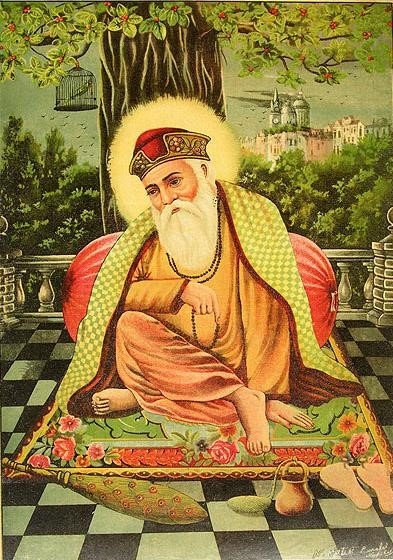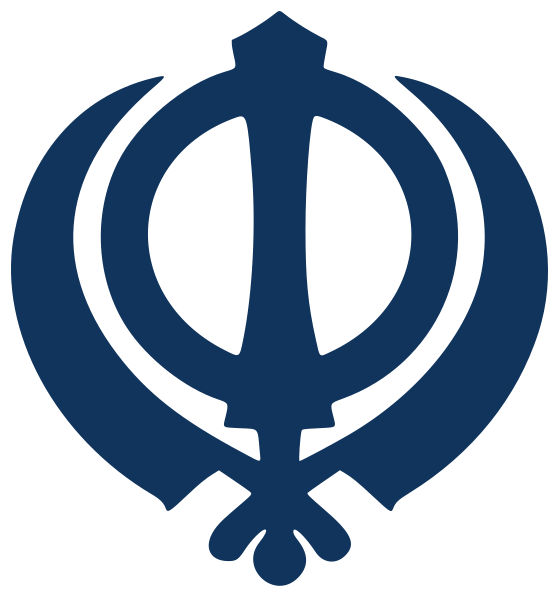

Guru Nanak was the founder of what is today known as the religion of Sikhism, Guru Nanak was the first preacher(Guru) of Sikhism. Guru Nanak has given the message of equality, brotherhood, and compassion. Guru Nanak’s teachings have synthesized both Hinduism and Islam, the earlier influence on Guru Nanak was from the Baba Kabir, Baba Farid, etc.
Guru Nanak dev Ji was born in the Talwandi village, which today is known as Nankana sahib in Pakistan. He was born in 1469 in the Lahor province of the Delhi sultanate. Guru Nanak was born in the Khatri sub caste. Initially, Guru Nanak was in employment but due to his attractiveness towards philosophy and religion, he gave up material life. Guru Nanak Ji travelled extensively throughout the world. He travelled to Varanasi, Ayodhya, Makka, Multan, and Jerusalem.

Raja Ravi Varma, Public domain, via Wikimedia Commons
Nanak was born in a Middle-class Khatri family to his mother Mata Tripta and father Mehta Kalu. Guru Nanak since childhood was not a usual person. He did not cry during his childhood even when he was hungry. He used to go to the pond near his house and sit there for many hours and meditate
Sacha Sauda - When his father came to the conclusion that guru Nanak is disinterested in farming activity so he tried to shift Guru Nanak’s attention to Business, he gave him twenty rupees to do the business transaction in the nearby town, but when he was on the journey to town, he saw a poor hungry people and donated all amount for the cause of hunger.
The other incident happened in guru Nanak's life when he was at his sister's house in Sultanpur Lodhi. Nanak went to a sister's house and started doing some work under the guidance of his sister’s husband. In Sultanpur, he used to meditate at the nearby river's bank. But there was a time when he didn't return home for three days. Once he retired home, silence gripped him, and the word he uttered is “there is no Hindu and Muslim”, this was the start of his teaching
Guru Nanak in His life made five spiritual journeys throughout the world −
First journey - This journey lasted for 7 years. He covered the parts of Punjab, Uttar Pradesh, and Assam during this time. Some of the prominent cities and towns he visited include Delhi, Panipat, Varanasi, Sialkot, pasture, etc. He gave the message of peace and salvation to the people. He attracted many people to his faith. This journey he made at the start of his 30s.
The second journey - In the second journey, Guru Nanak covered the Deccan plateau and reached Ceylon (Sri Lanka). This Udasi lasted for 7 years.
Third Spiritual Journey - In his third spiritual journey he covers the area of Kashmir, Tibet, Nepal, Sikkim, and Tashkent. He completed his journey in 5 year
Fourth spiritual journey - In his fourth journey, he visited the city of Mecca and many other Arab regions. This journey took him 3 years.
Fifth spiritual journey - In this journey he covered the area near his birth and death place, mostly the area of Punjab, where he spread his idea and gained most of his followers.
Vand Chakko - The Nanak talked about the virtue of giving and distributing whatever excess you have to the poor. It is a type of personal socialism and can be extended at the state level via state socialism. He said, “with the grace of the Lord, whatever you have received, share it with the needy and then consume.

The Khanda (Punjabi: ਖੰਡਾ, khaṇḍā) is the Symbol of the Sikh faith Which Attained its Current form Around the 1930s During the Ghadar Movement
Selfmade, CC BY-SA 4.0
Naam Japo - Is a form of meditation where one has to recite the name of god to achieve mental peace. He believed that a person can eradicate the bad feelings of ego, anger, and pride if he recites the name of god continually.
No discrimination - One of the main attractive teachings of Guru Nanak was no discrimination based on caste, creed, and religion. The social system of medieval India was hierarchical, to escape the hierarchical structure of both Muslim and Hindu society, many people adopted the path of Guru Nanak.
Sewa - The most attractive practice of today’s Sikh is the Sewa, this teaching was given by Guru Nanak to his followers. Today the Sikhs are known for their selfless service to humanity. They daily prepare free foods in their gurudwaras for anyone who visits, the langer is served to everyone without any discrimination of sex, caste, and religion.
Guru Nanak was the first guru of the Sikhs out of the ten Gurus, he is the founder of the religion of Sikhism, Sikhism is a large region in the Punjab state of India, Sikhism was prominent in united Punjab under British India but due to partition most of the Sikh migrated to east Punjab. Guru Nanak throughout his life tried to bring peace between Hindus and Muslims, he read Muslim Sufis as well as Hindu gurus and synthesized their teaching in the newly formed religion of Sikhism. Large numbers of Hindus and Muslims find peace in the teachings of Guru Nanak and follow the path of Sikhism. The ideas of Guru Nanak were compiled by Guru Arjun Singh the fourth guru of Sikhism in 1604.
Guru Gobind Sikh the 10th guru of Sikhs founded the Khalsa, an army to protect the Sikhs from the onslaught of the Mughals. Guru Gobind Sikh died in 1708 and Aurangzeb died in 1707, after Guru Gobind Sikh the leadership came to the hands of Banda Bahadur who founded the Sikh empire.
Q1. Name the rivers that flow from Punjab (east and west).
Ans. The name Punjab comes from the world and means five, the Punjab is the land of five rivers these rivers are −
Sutlej
Beas
Jhelum
Chenab
Ravi
Q2. Who was the founder of the modern Sikh empire?
Ans. Maharaja Ranjit Singh was the founder of the modern Sikh empire, before Maharaja Ranjit Sikh united Sikh polity, the Sikhs were divided into misls. These Misls were the small governing units that were ruled by different landlords. Maharaja Ranjit Singh united all misls under the sikh empire.
Q3. How many gurus does Sikhism have?
Ans. Sikhism has 10 gurus.
Guru Nanak - Founder of Sikhism
Guru Angad dev- chosen by Guru Nanak
Guru Amar das
Guru Ram das
Guru Arjan dev
Guru Har rai
Guru Har kishan
Guru Teg Bahadur
Guru Gobind Sikh- The last guru
Q4. Name any 2 prominent holy sites for Sikhs.
Ans. Nankana Sahib- This is the place where the first Guru, Guru Nanak was born and spent his childhood days. This place lies on the Pakistan side of Punjab.
Kartarpur sahib- The palace where Guru Nanak spent the last years of his life. This place is holy for the Sikh. This is in present-day Pakistan